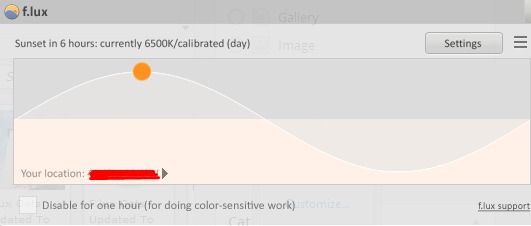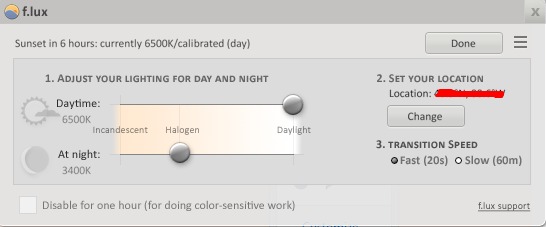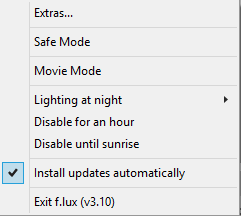Get to sleep after using your computer with f.lux

You’ve probably heard it a million times: don’t use your computer before bed. Unfortunately, many times we don’t have that kind of flexibility. Work has to be done, cross-continental Skype chats must be had, or a variety of other things. With a simple, low-memory app, you can fine-tune your screen to help you sleep at night.
Part of the reason your screen is hindering your sleep is that the kind of light emitted from your screen is meant to emulate sunlight. Your body’s circadian rhythm, or internal sleep clock, responds to things like the light around you. For your body, sunlight = daytime = do not emit the hormones that induce sleep.
Computer screens are specifically designed to be like sunlight, since that looks the most “pure” light for us. That’s great, during the day. We want the screen to look good and it is perfectly fine to be exposed to this sort of lighting during the day, when you want to be awake. The problem is when the sun sets. Have you ever seen someone on their laptop in the dark, and the light on their face looks blue? That’s the kind of white that a screen is calibrated to emit. It’s also the kind that keeps you awake.
F.lux has begun amassing an impressive array of scientific research demonstrating the detrimental effects of this “blue light” on sleep. What they find is that if you can calibrate your screen to be easier on the eyes at nighttime, by eliminating this blue light, you can make the transition to bedtime far easier.
What you will see is “warmer” colors on your screen as the sun sets, which are going to seem almost reddish. At first glance, you might be put off by how different it looks. The reason for the change is that it emulates the wavelengths of common household lighting, which will be easier on the eyes and signal to the brain that it is nighttime. While your first reaction may be that your screen suddenly doesn’t look right, you will find that within minutes you won’t even notice the difference.
Once you have installed the small download, you just tell f.lux where you live, so they know when to warm the light. During the daytime, your screen will look normal. At sunset, your screen will go through a warming phase. You can tell f.lux to do this all at once, going from no warmth to the fully tweaked warm light in about 30 seconds. If you find this too jarring, you can have it do it gradually over a period of an hour; in this case, we bet you won’t even notice the change happening. You will, however, probably get a lot better sleep.
If you need more exact color for some reason, you can access f.lux in your notifications bar in the bottom righthand of your Windows PC or top righthand area on Mac. It has an easy-access “pause for 1 hour” function. This will be useful if you want to watch a movie in true color or perhaps do photo/video editing where you need an accurate look at the colors. Just remember, you _will _be exposing yourself to that troublesome blue light!
A recent addition their feature set is “movie mode,” which affects the color change 2 and a half hours so that you can get a better look at your movies without losing all the protection of f.lux. Their FAQ has this to say about the feature, which is still in development:
We designed Movie Mode to preserve sky colors and shadow detail, while still providing a warmer color tone. It’s not perfect on either count, but it strikes a balance.
F.lux supports Windows, Mac, and most Linux distributions. It is totally free. If you have an Apple iDevice, f.lux is available only if you jailbreak. Android users do not have an official f.lux app, though one is in development. A copycat, Twilight, is available; it is free, does not require root, and works just fine. You may want to turn off the sticky notification, though, by long pressing on it, tapping “App Info” and then unchecking “show notifications.” Make sure to look out for f.lux’s arrival to Android and support them when they do.
Download f.lux for all platforms from their official website.
Featured image courtesy of Flickr user Johan.V.
COMMENTS
Search
Related Posts
Recent Posts
- Make Prism.js show line numbers by default (without CSS classes)
- Hemingway App 3.0 update review: A gimmick becomes a real app
- Hugo vs. WordPress page load speed comparison: Hugo leaves WordPress in its dust
- Hemingway App 2.0 update: A worthwhile update comes with unfortunate price hike
- How to view academic journal articles off campus using your library's proxy
categories
Support This Site
Bitcoin Donations:18DP9TGdPN5usTKMRMfPk6Q2mSr4mAz8NJLitecoin Donations:
LPKQbDPykwjXr5NbXfVVQH9TqM5C497A16

